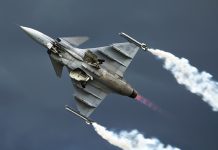Pakistan Media reported the country’s air force had successfully test-fired an indigenously-built ‘smart weapon’ from a JF-17 fighter.
Some Pakistani media outlets referred to the system as a ‘missile’ and others as an “extended-range smart weapon”. Several outlets also carried footage of the test of the ‘smart weapon’. Interestingly, the video of the test, from the Pakistan Air Force, shows only hazy imagery of the weapon and effectively obscures it with a ‘black box’ before it impacts the ground.
LCA-Tejas Squadron To Be Moved From South To Air-Base Near Pakistan Border: Air Chief
The perceived secrecy surrounding the ‘smart weapon’ has aroused debate about its origins and whether the test was meant as a PR exercise amid tension with India.
The Pakistan Air Force announced on Tuesday the smart weapon “has provided JF-17 Thunder a very potent and assured day and night capability to engage variety of targets with pinpoint accuracy.” Quwa Defence News & Analysis Group, a website that covers the Pakistani military, observed that the decision to obscure footage of the smart weapon meant the “PAF did not want to disclose the design or characteristics of the new munition.” Such a motive would, however, raise questions about the need to share video footage in the first place.
In 2017, the Pakistan Aeronautical Complex, which manufactures the JF-17, mentioned on its website about “the integration of standoff weapon with JF-17 Aircraft”, providing little additional information.
Pakistan is known to have developed the H2 and H4 ‘glide’ bombs with South African assistance. Glide bombs have pop-out wings to travel longer distances than laser-guided bombs and typically use electro-optical guidance. Pakistan’s The Dawn newspaper reported in 2003 that the H4 glide bomb had been inducted into service and claimed it had a range of up to 120km. These weapons have some similarities to the Israeli-origin SPICE munitions the Indian Air Force reportedly used in its strike on Balakot.
These glide munitions were primarily carried by the Pakistan Air Force’s fleet of upgraded Mirage III/V fighters, which are due for retirement. As the US is highly unlikely to allow the integration of such weapons on the F-16 fighters of the Pakistan Air Force, modifying the JF-17 to carry them would appear logical.
Global Industrial & Defence Solution (GIDS), a Pakistani company, has claimed to have developed a variety of guided weapons for aircraft, including range extension kits for existing unguided bombs and the Takbir, a 250kg glide bomb. Interestingly, social media users claimed the Takbir was the smart weapon tested recently and circulated images of a JF-17 carrying a Takbir.
In addition to bombs, the Pakistan Air Force has conducted multiple tests of a cruise missile called the Ra’ad since 2007, again using a Mirage III/V aircraft.
It is likely the ‘mystery’ over the precise nature of the ‘smart weapon’ will continue even as Pakistan celebrates achieving a capability it has had for years!
More News at EurAsian Times
- Indian Military Base in Vietnam To Protect Hanoi’s Territorial Interest
- Indian Military Base in Sabang can Strangle China at the Strait of Malacca
- Saudi Money, US Weapons, Israeli Intelligence Fuelling Arab NATO – Iran
- Will Ayni Airbase in Tajikistan Become India’s 1st Overseas Military Base?
- Indonesia Opens Another Military Base at Natuna Islands To Counter Aggressive China




